Science Highlights, February 18, 2015
Awards and Recognition
Capability Enhancement
Novel sample introduction system developed for material-at-risk (MAR) reduction
Materials Physics and Applications
Novel crystal growth technique developed for high efficiency perovskite solar cells
Awards and Recognition
Seminal paper on materials modeling receives 1,000 citations
An Acta Materialia paper written by Ricardo Lebensohn and Carlos Tomé (Materials Science in Radiation and Dynamics Extremes, MST-8) has celebrated two decades, reaching the 1,000-citation mark, according to Google Scholar.
In “A Self-consistent Anisotropic Approach for the Simulation of Plastic Deformation and Texture Development of Polycrystals: Application to Zirconium Alloys,” the authors provided a numerically efficient and physically sound homogenization-based model for simulating plastic deformation of polycrystalline materials. The formulation is fully anisotropic both at single crystal and polycrystal levels. This feature makes the associated viscoplastic self-consistent (VPSC) code, maintained and distributed from Los Alamos National Laboratory, useful for simulations of mechanical behavior of low-symmetry materials. These materials include: hexagonal zirconium, magnesium, beryllium, and titanium, and orthorhombic uranium metallic alloys; semi-crystalline polymers; and geologic materials such as ice, calcite, quartz, and perovskites.
Since publishing the original model in 1993, the authors and other collaborators have constantly improved the scope of the formulation and the efficiency of the VPSC code, making it a platform that allows users to implement different regimes and constitutive laws for the constituent crystals. Examples include hardening laws based on dislocation density evolution, twinning models based on stochastic twin nucleation and propagation, irradiation growth and creep models for simulations of in-reactor dimensional changes, recrystallization models, damage evolution via the growth of cavities, and stress-induced transformations during plastic deformation. More recently, researchers have implemented VPSC as a user-defined material subroutine in finite element codes (ABAQUS, EPIC, MOOSE, and ALE3D) for the simulation of complex deformation processes of aluminum, steel, zirconium, titanium, magnesium, and uranium components

Photo. (Left to right): Carlos Tomé and Ricardo Lebensohn have collaborated for 20 years.
Lebensohn and Tomé, who performed their initial research in Argentina, continue their long-standing collaboration. They improved the VPSC formulation for different Los Alamos programmatic applications. The team distributed the VPSC code to external researchers, making it available to more than 300 users in academia, national laboratories, and industry. This widespread use indicates the original publication’s impact in the materials science community.
Tomé, who has a PhD in physics from the National University of La Plata, Argentina, joined the Laboratory in 1996. Lebensohn, who has a PhD in physics from the National University of Rosario, Argentina, joined LANL’s Materials Science and Technology (MST) Division in 2003.
Reference: R.A. Lebensohn and C.N. Tomé: “A Self-consistent Anisotropic Approach for the Simulation of Plastic Deformation and Texture Development of Polycrystals: Application to Zirconium Alloys,” Acta Metallurgica et Materialia 41, 2611 (1993); doi: 10.1016/0956-7151(93)90130-K.
Continuing VPSC work at Los Alamos is currently funded by the DOE’s Office of Basic Energy Sciences (LANL Program Manager Toni Taylor), NNSA Advanced Simulation and Computing Program - Physics and Engineering Models (LANL Project Leader Mark Schraad), the Consortium for Advanced Simulation of Light Water Reactors (LANL Program Manager Christopher Stanek), DoD/DOE Joint Munitions Program (LANL Program Manager Thomas Mason), and the DOE’s Office of Advanced Scientific Computing Research - Exascale Co-Design Center for Materials in Extreme Environments (LANL Center Leader Tim Germann). The work supports the Laboratory’s Energy Security and Nuclear Deterrence mission areas and Materials for the Future and Information, Science, and Technology science pillars by providing a computational tool enabling the science and engineering required to establish novel design principles and manufacturing processes for advanced materials. Technical contacts: Ricardo Lebensohn and Carlos Tomé
Bioscience
High quality sequencing from smaller samples
Bacterial genome sequencing supports applications in clinical and agricultural diagnostics, outbreak detection and monitoring, human health studies, biocatalysis, and environmental studies. However, sequencing bacterial genomes has traditionally required large amounts of genomic DNA (∼1 𝜇g) to ensure enough redundancy for quality data to be obtained. Samples of DNA used to be “grown up” or copied in bacterial cultures before they could be sequenced; more recently, they have been copied using an artificial replication technique called polymerase chain reaction (PCR). When an environmental or clinical sample of DNA is sequenced, researchers are concerned about maintaining the integrity of the nucleic acid while producing enough copies to get quality sequence data. With the latest improvements in sequencing technology, the amount of initial DNA sample needed has been reduced dramatically. Nevertheless, there have been few studies to determine the effects of the input DNA amount or library preparation method on the quality of sequencing data. Several new commercially available library preparation methods enable bacterial genome sequencing from as little as 1 ng of input DNA. Los Alamos researchers and colleagues analyzed this question in their paper “Facile, High Quality Sequencing of Bacterial Genomes from Small Amounts of DNA,” published in the International Journal of Genomics.
The team of genome scientists evaluated the utility of a commercial kit (NEBNext Ultra) for resequencing and de novo assembly of four bacterial genomes and compared its performance with the TruSeq library preparation kit. They sequenced three different bacterial species with various genome lengths (from 5.4 to 6.7 million base pairs, Mb) and containing guanine-cytosine (GC) nitrogenous base contents ranging from 35% to 68%. High GC content usually results in more sequencing mistakes. Standard input DNA amounts were 100 ng, approximately 10 times lower than the required amount for the Illumina TruSeq kit and 10 times higher than the minimum DNA inputs per NEBNext Ultra manual specifications. The researchers used minimal DNA inputs (10 ng) to sequence the most challenging (longest genome and highest GC content) bacterial genomes (Burkholderia A and B).
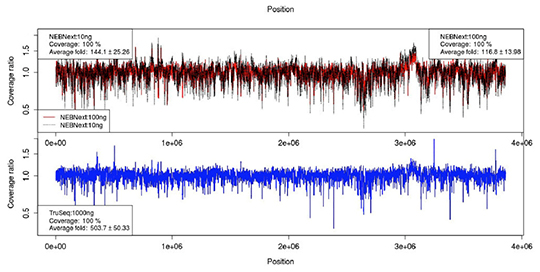
Figure 1. Evenness of sequencing across the entire chromosome of the bacterium Burkholderia thailandensis is not affected even when only 10 ng of DNA is used.
The genome coverage was remarkably similar regardless of the library preparation method (NEBNext or TruSeq). The NEBNext libraries prepared from just 10 ng of genomic DNA maintained the high quality of genome assembly and produced similar numbers of contigs (sections of overlapping sequence data) as with 100 ng input DNA samples. The team demonstrated that the quality of bacterial genome resequencing and de novo assembly is comparable, regardless of the library preparation method and input DNA amount (from 10 to 1000 ng). This assurance of quality data could save researchers valuable time by not having to replicate large amounts of nucleic acid when evaluating a DNA sample.
Reference: “Facile, High Quality Sequencing of Bacterial Genomes from Small Amounts of DNA,” International Journal of Genomics, Article ID 434575 (2014); doi: 10.1155/2014/434575. Researchers include: Momchilo Vuyisich, Karen Davenport, Cheryl Gleasner, Kim McMurry, Matthew Scholz, and Patrick Chain (Bioenergy and Biome Sciences, B-11); Ayesha Arefin (Biosecurity and Public Health, B-10); Shihai Feng (Theoretical Biology and Biophysics, T-6); Beverly Parson-Quintana (Industrial Safety and Hygiene, OSH-IS); and Jennifer Price (Parkview Medical Center School for Medical Laboratory Science).
The Defense Threat Reduction Agency (DTRA) funded the work, which supports the Lab’s Global Security and Energy Security mission areas and the Science of Signatures science pillar through the ability to sequence bacterial genomes. Technical contact: Momo Vuyisich.
Capability Enhancement
Novel sample introduction system developed for material-at-risk (MAR) reduction
LANL’s newly built Radiological Laboratory Utility Office Building (RLUOB) will replace the aging Chemistry and Metallurgy Research (CMR) facility that is due to be decommissioned in 2019. The Actinide Analytical Chemistry (C-AAC) group uses inductively coupled plasma-optical emission spectroscopy (ICP-OES) to analyze for trace impurities in plutonium materials. Relocating this analytical capability into the RLUOB presents technical challenges because of the stringent material-at-risk (MAR) requirements, which are less than 1/600th of what is allowed at the CMR. MAR requirements include both samples in process and as waste.
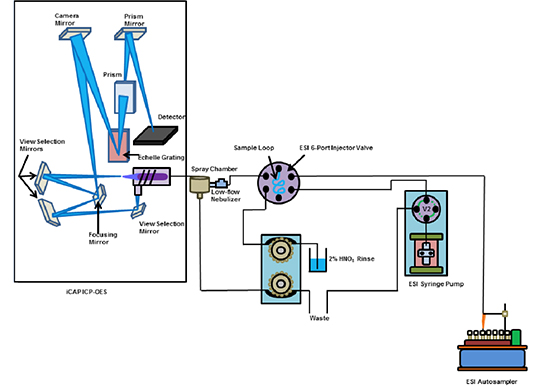
Figure 2. Schematic of the iCAP ICP-OES integrated with the microFAST system and low flow rate nebulizer.
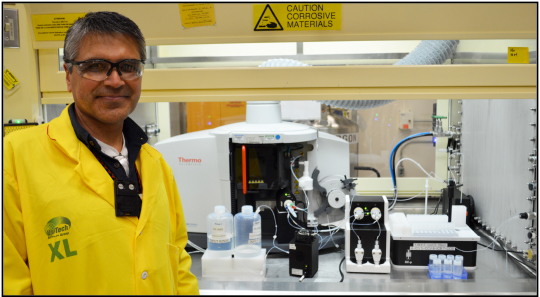
Photo. Dennis Montoya stands next to a fume hood with the new analytical instrumentation.
Earth and Environmental Sciences
Assessing the efficiency of in-situ recovery of uranium mining
In-situ recovery (ISR) is a solution mining technique that involves the injection of oxygen- and carbon dioxide-fortified water to extract uranium (U) from low-grade ore deposits economically while avoiding the production of tailings and U-bearing dust associated with conventional open-pit and/or underground mining operations. The fortified water ISR process alters the geochemical conditions in the subsurface to create conditions that are more favorable to the migration of uranium and other metals associated with the uranium deposit. The uranium-rich solutions are pumped to the surface for U recovery using ion-exchange methods. Following ISR mining, restoration is typically conducted by sweeping the mined ore body with aquifer water drawn from outside the ore zone (groundwater sweep) and then treating the ore zone water by reverse osmosis. The main challenges with ISR mining are the inability to access all of the uranium in the ore zone; and, more importantly, the difficulties in restoring groundwater to baseline conditions and the mined host rocks to chemically reducing conditions capable of immobilizing any residual uranium or other contaminants.
A scientific team from LANL and the University of California - Berkeley examined several core samples provided by Cameco Resources Inc., from its Smith Ranch-Highland facility in Wyoming. The facility hosts the largest in-situ recovery operation in the United States. Although previous work has characterized uranium-bearing deposits prior to mining, information is sparse regarding how ISR mining affects the ore zone. The researchers conducted detailed characterization of samples from cores mined by ISR methods from 1999 to 2005 and designated as being “in restoration” starting in 2010. The team aimed to: 1) identify and evaluate mining signatures that might improve restoration methods, 2) distinguish a method to reduce and prevent significant uranium migration out of the previously mined areas, and 3) gain insights into the efficiency of hydrologic sweep of uranium during ISR mining. The journal Chemical Geology published the research.

Figure 3. Scanning electron microscopy (SEM) images of organic-rich 779 Dark from a uranium ore zone, showing considerable amounts of U (white) and pyrite (P, grey) crystallized on fractured carbonaceous fragments and matrix (A and C), rock fragment (B), and quartz grain (C).
An understanding of the chemical speciation of uranium in postmined ore material and the nature of associated minerals and geochemical conditions would help in evaluating and applying remediation strategies. Knowledge of the structure and chemical speciation of uranium and associated minerals in post-mined ore deposits will help define the geochemical environments that exist in the subsurface after ISR mining. Insights into conditions and processes responsible for the continued release of uranium and other trace metals from previously mined zones should help in developing more robust restoration methods.
The researchers discovered significant amounts of residual uranium trapped in sediments containing organic matter and a reduced form of iron (pyrite, iron sulfide), whereas the sweep was complete in organic-poor sediments (Figures 3 and 4). The results suggest that organic rich ore zones might have played a significant role in accumulating uranium and continue to act as a significant reservoir for uranium and other trace metals. Uranium associated with the carbonaceous materials appears to be present predominantly as U(IV)-carboxylate complexes. The uranium found with organic matter seems to either resist oxidation or is inaccessible to leaching fluids. Although these areas retained significant uranium, they might not contribute significantly to uranium attenuation because they are likely disconnected from the main hydraulic flow system. Residual pyrite in these swept zones might have acted as a reducing phase to partially attenuate uranium.
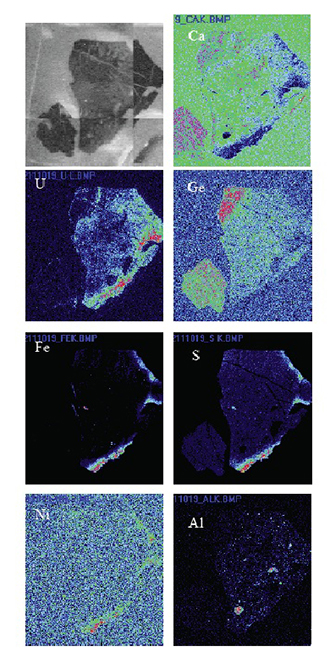
Figure 4. µXRF elemental maps of trace metals of a thin section of a carbonaceous fragment (779 dark) recorded using a 10 m per pixel resolution on a sample that is few centimeters large.
The micro x-ray fluorescence (μXRF) elemental maps indicate discrete zones with high concentrations of uranium (U), nickel (Ni), iron (Fe), calcium (Ca), and sulfur (S), and germanium (Ge) along the edge of a carbonaceous fragment (Figure 4). The iron, nickel, and sulfur associations signify the abundance and co-location of iron and nickel sulfide minerals, but without apparent uranium association. The uranium-rich surfaces appear to be spatially separated from the high-iron zones. Moreover, an isolated germanium-enriched zone occurs in a different part of the carbonaceous fragment. The μXRF elemental maps show poor correlation between the highest concentrations of iron and uranium despite the close association of both minerals (i.e., uranium and pyrite) as shown in the SEM data (Figure 3). These results suggest sequential formation of the iron and uranium phases rather than concurrent formation.
The integrated petrographic, mineralogical, and structural information gained by analyzing core fragments from a previously mined uranium ore zone provide significant insight into the: 1) sedimentological and burial diagenetic processes of the host rocks, 2) nature of the ore zones, and 3) factors that influence ISR mining and the fate and transport of contaminants downgradient of the mined unit. The findings suggest that carbonaceous materials that are abundant in the sandstone host rocks might have played a significant role in accumulating uranium and continue to act as a significant reservoir for uranium and other trace metals. The researchers are continuing detailed investigations to determine the nature of the uranium phases and their long-term stability.
Reference: “Characterization of Cores from an In-situ Recovery Mined Uranium Deposit in Wyoming: Implications for Post-mining Restoration” Chemical Geology 390, 32 (2014); doi: 10.1016/j.chemgeo.2014.10.009. Authors include: G. WoldeGabriel, H. Boukhalfa, S. D. Ware, M. Cheshire, P. Reimus, J. Heikoop, B. House, and A. Simmons (Earth Systems Observation, EES-14); S. D. Conradson (Materials Science in Radiation and Dynamics Extremes, MST-8); G. Havrilla and O. Batuk (Chemical Diagnostics and Engineering, C-CDE); J. Clay (Cameco Resources Inc.) A. Basu, J. N. Christensen, S. T. Brown, and D. J. DePaolo (University of California - Berkeley).
The University of California Laboratory Fee Program funded the research, which supports the Lab’s Energy Security and Global Security mission areas and the Science of Signatures science pillar. Technical contact: Giday WoldeGabriel
LANSCE
LANSCE School on Neutron Scattering morning lectures open to all employees
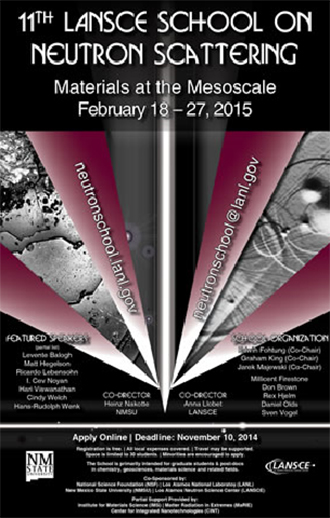
The 11th LANSCE School on Neutron Scattering is scheduled February 18-27 and will focus on science of Materials at the Mesoscale. The School will examine the influence of surfaces, interfaces, meso- and micro-structure on the functionality of materials. The lectures are open to all employees and will be held at the Rosen Auditorium (TA-53, Bldg 1) beginning on February 19, with the opening lecture, “Introduction to Mesoscale Sciences: From Quanta to the Continuum: Opportunities for Mesoscale Science,” presented by John Sarrao, associate director for Theory, Simulation, and Computation (ADTSC). The schedule and the abstracts are posted at the 11th LANSCE School on Neutron Scattering website.
The National Science Foundation, LANSCE, New Mexico State University, LANL, Institute for Materials Science, Center for Integrated Technology, and MaRIE: Matter Radiation Interactions in Extremes are sponsors. Anna Llobet (LANSCE Weapons Physics, P-27) and Heinze Nakotte (New Mexico State University) co-direct the school. Technical contact: Anna Llobet
Materials Physics and Applications
Novel crystal growth technique developed for high efficiency perovskite solar cells
State-of-the-art photovoltaics – using high-purity, large-area, wafer-scale single-crystalline semiconductors grown by sophisticated, high temperature crystal-growth processes – offer promising routes for developing solar-based clean energy for the future. Solar cells composed of the recently discovered material organic-inorganic perovskites offer the efficiency of silicon, yet suffer from a variety of deficiencies limiting the commercial viability of perovskite photovoltaic technology. The deficiencies are instability, non-reproducibility, and hysteresis during device operation (possibly due to defect-assisted trapping). Los Alamos researchers and collaborators have developed a process to grow perovskite films that overcomes the technical challenges blocking commercial viability. The journal Science published their findings.
The team revealed a new solution-based hot-casting technique to grow continuous, pinhole-free thin films of organometallic perovskites that eliminates these limitations. The method enables the preparation of high-quality, large-area, millimeter-scale perovskite crystals and demonstrates that highly efficient and reproducible solar cells with reduced trap assisted recombination can be realized. The hot-casting technique enables the prolonged growth of the perovskite crystal grain, yielding large crystalline grains. The team suggests that there are two primary benefits of growing crystals with large grain size: 1) The reduced interfacial area associated with large grains suppresses charge trapping and eliminates hysteresis, and 2) larger grains have lower bulk defects and higher mobility, allowing for the photogenerated carriers to propagate through the device without frequent encounters with defects and impurities. The crystalline quality of the perovskite films is comparable with that of high-quality silicon and gallium arsenide semiconductors.
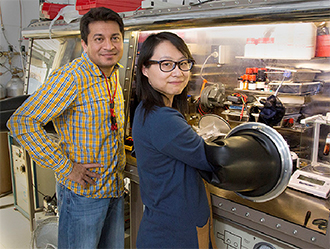
Photo. Aditya Hohite and Wanyi Nie (Materials Synthesis and Integrated Devices, MPA-11) perfect a crystal production technique to improve perovskite crystal production for solar cells.
The researchers fabricated planar solar cells with efficiencies approaching 18%, among the highest reported in the field of perovskite-based light-to-energy conversion devices. The cells demonstrate little cell-to-cell variability, resulting in devices showing hysteresis-free photovoltaic response. Photovoltaic hysteresis had been a fundamental bottleneck for stable operation of previous perovskite devices. The team’s characterization and modeling results attribute the improved performance to reduced bulk defects and improved charge carrier mobility in large-grain devices.
The method offers promising routes to develop low-cost, solar-based clean global energy solutions for the future. The benefit is a solution-processible technology that can form the active material for solar cells using a relatively low-temperature process (100-200C). In contrast, silicon requires high temperature, expensive, sophisticated crystal growth techniques to produce the quality required to make efficient solar cells. The researchers anticipate that their solution-based crystal growth technique could lead to synthesis of wafer-scale crystalline perovskites necessary for the fabrication of high-efficiency solar cells. The method is applicable to several other material systems plagued by polydispersity, defects, and grain boundary recombination in solution-processed thin-films. The casting method is appropriate for both pure and mixed halide perovskite combinations and might lead to the production of industrially scalable large-area crystalline thin films made from other materials for solution-processed, large-area crystal growth.
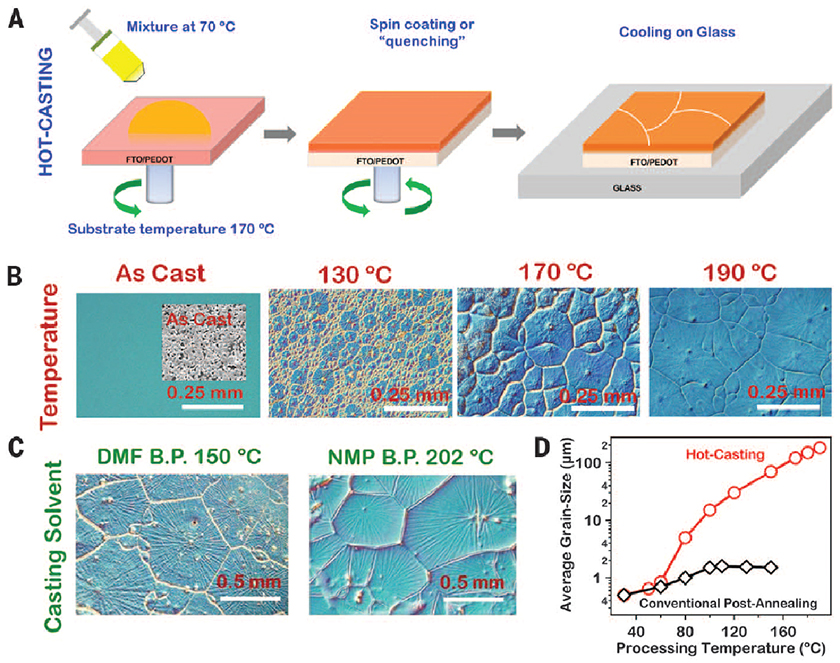
Figure 5. Processing scheme for perovskite thin film using hot-casting methods and observations for large-area millimeter-scale crystal grain formation for a perovskite (PbCH3NH3I3-xClx) based thin film. (A) Hot-casting scheme for large-area crystal growth [ITO, indium tin oxide; FTO, fluorine-doped tin oxide; PEDOT, poly(3,4-ethylenedioxythiophene) polystyrene sulfonate]. (B) Optical micrographs illustrating grain formation as a function of substrate temperature with the casting solution maintained at 70°C. (C) Large area grain formation using casting solvents with high boiling points (DMF, N,N-dimethlformamide; NMP, N-methyl-2-pyrrolidone). (D) Comparison of grain size as a function of processing temperature obtained for the hot-casting and conventional post-annealing methods.
Reference: “High-efficiency Solution-processed Perovskite Solar Cells with Millimeter-scale Grains,” Science 347, 522 (2015); doi: 10.1126/science.aaa0472. Authors include Wanyi Nie, Gautam Gupta, and Aditya D. Mohite (Materials Synthesis and Integrated Devices, MPA-11); Hsinhan Tsai, Jean-Christophe Blancon, Jared J. Crochet, and Hsing-Lin Wang (Physical Chemistry and Applied Spectroscopy, C-PCS); Amanda J. Neukirch and Sergei Tretiak (Physics and Chemistry of Materials, T-1); Reza Asadpour and Muhammad A. Alam (Purdue University); and Manish Chhowalla (Rutgers University).
The DOE Office of Basic Energy Sciences and a Laboratory Directed Research and Development (LDRD) project funded different aspects of the LANL work. This research was performed in part at the Center for Integrated Nanotechnologies (CINT), a DOE Office of Science User Facility. The work supports the Laboratory’s Energy Security mission area and Materials for the Future science pillar through the development of materials for high efficiency solar cells to generate electricity. Technical contact: Aditya MohitePhysics
Prototype gamma ray imaging microscope tested at Duke University
Inertial confinement fusion (ICF) experiments on the National Ignition Facility (NIF) are designed to implode a spherical capsule containing deuterium-tritium (DT) fuel, which compresses and heats the fuel to initiate thermonuclear burn in a hotspot at the center of the capsule. NIF uses laser beams to implode the fuel to cause nuclear fusion reactions for stockpile stewardship and energy production research. The paucity of diagnostic information about the compressed target near stagnation is a significant challenge for understanding the performance of implosions of DT filled capsules on the National Ignition Facility. Ignition performance is directly tied to the areal density of the fuel payload. Scattered neutron images and down scattered neutron ratios are often inconsistent with each other, as well as simulated performance. This can lead to uncertainty about the exact state of the fuel payload.
To resolve these inconsistencies and to enable time-resolved imaging of the fuel assembly, Los Alamos scientists, in collaboration with the Center for Gamma Ray Imaging (CGRI) at the University of Arizona - Tucson, have developed a prototype gamma-ray imaging microscope (GRIµ) to image MeV-scale gamma rays that are emitted during the implosions of NIF capsules. Images of 4.4 MeV gamma rays show the location of carbon ablator material, relative to the deuterium/tritium fuel, and provide a critical constraint on the volume and shape of the compressed assembly.
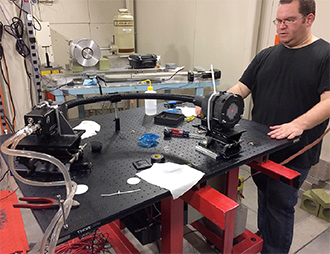
Photo. Daniel Lemieux with the prototype GRIµ system being prepared for calibration and characterization tests at the High Intensity Gamma-Ray Source (HIGS).
Daniel Lemieux (Plasma Physics, P-24, and CGRI) designed and built the prototype microscope. He performed characterization tests using the High Intensity Gamma-Ray Source (HIGS), which the Triangle Universities Nuclear Laboratory operates at Duke University. Lemieux teamed with his dissertation advisers, Gary Grim (formerly LANL, now Lawrence Livermore National Laboratory) and Brad Barber (University of Arizona), on the project. Researchers collected several hundred images with the prototype microscope during three full days of taking beam.
Previously, the prototype collected time-integrated radiographs of plastic shells imploded by the Omega laser at the University of Rochester. Bremsstrahlung radiation from hot electrons generated at the critical surface of the laser-illuminated plastic shell created the radiographs. Because this radiation is relatively soft (~100 keV compared with the 4.4 MeV energy that the system is designed to measure), the GRIµ team took the prototype to the High Intensity Gamma-Ray Source to perform system characterization and calibration at the desired energy.
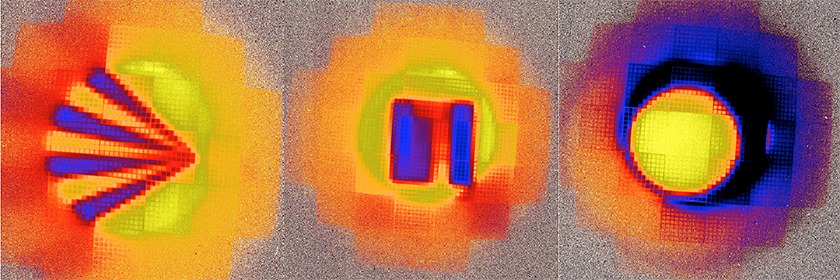
Figure 6. Image data collected at HIGS using the Los Alamos GRIµ camera. (Left): A simple high contrast phantom target of tungsten wedges. (Center): A slit object formed with tungsten blocks. The team will analyze this slit image and a tungsten edge image to assess the camera system resolution. (Right): A simulated penumbral image of a plastic shell in a National Ignition Facility (NIF) implosion. This image will be reconstructed, similar to what is done for the NIF neutron imaging system, and compared with the data used to create the test object that generated the image.
The Inertial Confinement Fusion and High Yield Campaign (LANL Program Manager Steve Batha) funded the work, which supports the Lab’s Nuclear Deterrence and Energy Security mission areas and the Nuclear and Particle Futures (High Energy Density Plasmas and Fluids) and Science of Signatures science pillars. Technical contact: Daniel Lemieux
Theoretical
Modeling ocean mixing
Many scientists expect that carbon emitted from the burning of greenhouse gases and the accompanying heat within the atmosphere will be predominantly sequestered within the deep ocean. Understanding the mechanisms and quantifying the rate and variability of this sequestration is an outstanding scientific question and has profound implications for the rate of atmosphere warming over the next century.Earth system simulations for the study of climate and climate change are now beginning to include “weakly-eddying” ocean model components. Mixing in the global ocean occurs primarily due to large-scale mixing along surfaces of constant density by large, mesoscale (10 - 100 km) eddies. These eddies arise from conversion of potential energy, stored in tilted density surfaces produced by wind and heat fluxes, into kinetic energy. Tilting density surfaces can also intersect the water surface and carry heat, carbon, and other biogeochemical tracers into the deep ocean to aid carbon and heat sequestration. The mixing rate along these density surfaces is driven by fluid straining due to mesoscale eddies and is quantified by scalar diffusivity.
Los Alamos researchers aim to quantify the horizontal and vertical structure of the ocean’s scalar diffusivity and its dependence upon velocity spatial scale. Previous attempts to map diffusivity have been hampered by utilization of highly diffusive Eulerian scalar advection schemes or off-line Lagrangian particle tracking. (In Eulerian simulations the spatial grid is fixed; while in the Lagrangian the grid, i.e, the particles, move with the fluid.) The new Lagrangian In-situ Global High-performance particle Tracking (LIGHT) analysis module within the Model for Prediction Across Scales Ocean (MPAS-O) overcomes these issues because it directly integrates the velocity field with minimal numerical mixing and is lightning fast, using the same time step and velocity information driving the native Eulerian ocean simulation. MPAS-O is a global, multiscale, ocean model that simulates spatial and temporal scales ranging from coastal dynamics to basin-wide circulations. Laboratory scientists developed both the LIGHT analysis module and the MPAS-O ocean model.
Numerical simulation of particle trajectories provides a complementary Lagrangian description of the fluid motion as compared with the standard Eulerian description. Analysis of over 9 × 106 particles in 30 ensemble members allows direct computation of the fluid diffusivity. The team performed simulations in an idealized mid-latitude ocean basin to Simulate Mesoscale Ocean Activity (SOMA) and eddy mixing. LANL researchers designed the SOMA model to investigate equilibrium mesoscale activity in a setting similar to the way that ocean climate models are deployed. The researchers performed simulations at 4, 8, 16, and 32 km resolution.
The team computed diffusivity within a frame of reference relative to mean fluid motion, as shown in the Figure 7 top panel. Each arrow designates the mean motion of an ensemble of particles over a 60-day period. Shaded grey areas designate the spread of particles with respect to the ensemble mean. The paths reveal that recirculation, with minimal mixing, occurs on the continental shelf. On the interior basin, the paths demonstrate that wind forcing drives a strengthened subtropical gyre with respect to a subpolar gyre. These gyres form western boundary currents, which coalesce and separate to form a meandering, eastward zonal jet. The rate at which the width of the shading increases when moving along the mean particle path indicates the rate of particle dispersion, which is the diffusivity. The simulations show that scalar diffusivity is largest within the western boundary currents and meandering jet regions. Three-dimensional spatial structure calculations indicate that diffusivities are greatest near the surface, and attenuation occurs at depth (Figure 7 bottom panel). The results highlight the capability of LIGHT to compute the horizontal and vertical structure of diffusivity within the high performance computing MPAS-O framework.
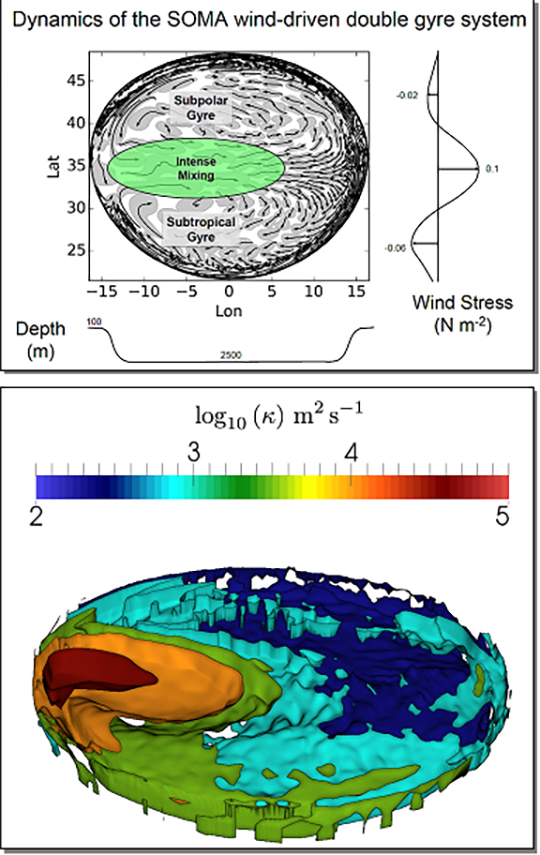
Figure 7. (Top panel): Particle ensemble mean paths, designated by black arrows, and ensemble covariances, designated by grey shaded areas, along a mid-depth density surface within the SOMA simulation. Lat is latitude, and Lon is longitude. (Bottom panel): Three-dimensional spatial structure of computed diffusivity using Lagrangian Particles for the SOMA simulation. is diffusivity. The maximum diffusivity occurs in the turbulent jet in the west (left portion of the figure).
Discovery of important spatial and temporal scales driving mixing is vital to ocean and climate modeling. Knowledge of dominant scales associated with mesoscale eddies is useful to better understand resolution requirements for future Coupled Model Intercomparison Projects (e.g., CMIP6), particularly at weakly-eddying resolutions. Deep ocean heat and carbon storage are dependent on heat transfers driven by mesoscale eddy mixing. Global climate simulations are just beginning to be able to resolve the largest of these key scales. However, some degree of mixing due to these eddies is ultimately lost in present underresolved simulations. The researchers expect that the improved understanding of mesoscale eddy mixing will lead to enhanced subgrid scale mixing parameterizations that increase global climate simulation accuracy through better representation of deep ocean heat and carbon fluxes.
Reference: “Diagnosing Isopycnal Diffusivity in an Eddying, Idealized Mid-latitude Ocean Basin via Lagrangian In-situ, Global, High-performance particle Tracking (LIGHT)”, submitted for publication. Authors include: Phillip J. Wolfram, Todd D. Ringler, Mathew E. Maltrud, and Douglas W. Jacobsen (Fluid Dynamics and Solid Mechanics, T-3); and Mark R. Petersen (Computational Physics and Methods, CCS-2).
This research was supported by the Office of Science, Office of Biological and Environmental Research of the DOE Regional and Global Climate Modeling Program (RGCM) and used computational resources provided by the Los Alamos National Laboratory Institutional Computing facility. The work supports the Lab’s Global Security mission area and the Information, Science, and Technology science pillar through enhanced ocean model components of global climate simulations. Technical contact: Phillip Wolfram






